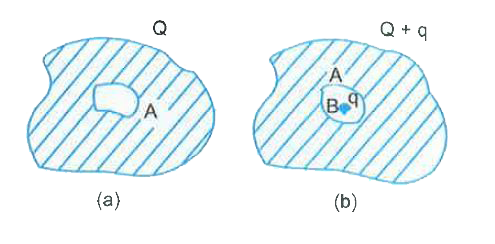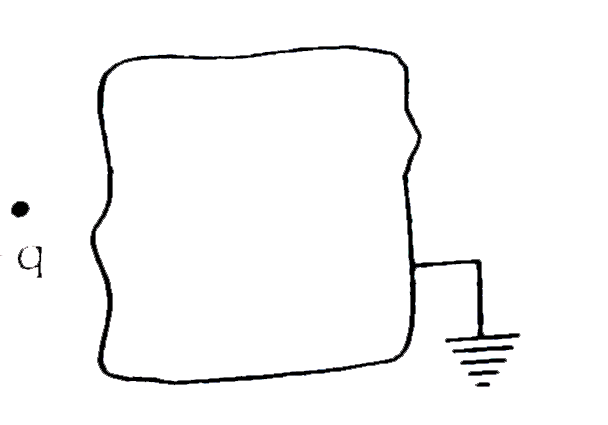(a) A conductor A with a cavity as shown in Fig, is given a charge Q. Show that the entire charge must appear on the outer surface of the conductor.
(b) Another conductor B with charge q is inserted into the cavity keeping B insulated from A. Show that the total charge on the outside surface of A is fig.
(c) A sensitive instrument is to be shielded from the strong electrostatic field in its environment. Suggest a possible way.

(a) Visualise a Gaussian surface just inside the outer surface of the conductor. The electric field intensity everywhere on this Gaussian surface will be zero, The electric flux linked with the selected Gaussian surface becomes zero, hence as per Gauss.s law the net enclosed charge must be zero. Therefore whatever charge is given to the conductor, it will come to the outer surface of the conductor.
(b) The chargeq at the centre of the cavity induces -q charge on the inner surface of the cavity, thus q charge is induced on the outer surface of the conductor. The original charge with the conducting object was Q and therefore now Q+q charge will be distributed on the outer surface of the conductor.
(c )The region enclosed by the metallic object is electrostatically shielded. So, we need to cover the instrument by a metal surface from all sides. The cavity inside the conductor can be ued for this purpose.
Topper's Solved these Questions
- BOOK - MODERN PUBLICATIONCHAPTER - ELECTRIC CHARGES AND FIELDS EXERCISE - Ncert File (Ncert (Exemplar Problems) )25videos
ELECTRIC CHARGES AND FIELDS
- BOOK - MODERN PUBLICATIONCHAPTER - ELECTRIC CHARGES AND FIELDS EXERCISE - Higher Order Thinking Skills & Advanced Level (Questions With Answers)5videos
ELECTRIC CHARGES AND FIELDS
- BOOK - MODERN PUBLICATIONCHAPTER - ELECTRIC CHARGES AND FIELDS EXERCISE - Tough & Tricky Problems20videos
ELECTRIC CHARGES AND FIELDS
- BOOK - MODERN PUBLICATIONCHAPTER - DUAL NATURE OF RADIATION AND MATTER EXERCISE - CHAPTER PRACTICE TEST15videos
DUAL NATURE OF RADIATION AND MATTER
- BOOK - MODERN PUBLICATIONCHAPTER - ELECTROMAGNETIC INDUCTIONEXERCISE - CHAPTER PRACTICE TEST FOR BOARD EXAMINATION14videos
ELECTROMAGNETIC INDUCTION
Similar Questions
(a) A conductor A with a cavity as shown in Fig, is given a charge Q. Show that the entire charge must appear on the outer surface of the conductor.
(b) Another condutor B with charge q is inserted into the cavity keeping B insulated from A. Show that the total charge on the outside surface of A si (Q+q) fig.
(c) A sensitive instument is to be shielded from the strong electrostatic field in its enviroment. Suggest a possibe way.
 View Solution
View SolutionA conductor A with a cavity as shown in is given a charge Q. show that the entire charge must appear on the outer surface of the conductor.

Another conductor B with charge q is inserted into the cavity keeping B insulated from A. Show that the total charge on the outside surface of A is Q+q
(c) A sensitive instrument is to be shielded from the strong electrostatic fields in its environment. Suggest a posible way.View Solution
Knowledge Check
- Question 1 - Select One
If q is the charge per unit area on the surface of a conductor, then the electric field intensity at a point on the surface is
A(qε0) normal to surfaceB(q2ε0) normal to surfaceC(qε0) tangential to surfaceD(q2ε0) tangential to surface - Question 2 - Select One or More
In front of an earthed conductor a point charge +q is placed a shown in figure
 AOn the surface of conductor the net charge is always negativeBOn the surface of conductor at some points charges are negative and at some points charges may be positive distributed non uniformlyCInside the conductor electric field due to point charge is non zeroDNone of these
AOn the surface of conductor the net charge is always negativeBOn the surface of conductor at some points charges are negative and at some points charges may be positive distributed non uniformlyCInside the conductor electric field due to point charge is non zeroDNone of these - Question 3 - Select One
Work done in moving a charge q coulomb on the surface of given charged conductor of potential V is
AVq jouleBVq jouleCqV jouleDZero
Show that the electric field at the surface of a charged conductor is proportional to the surface charge density.
View SolutionWhat is an equipotential surface ? Show that the electric field at a point on the surface of a charged conductor or just outside it is perpendicular to the surface ?
View SolutionThe ratio of charge on left surface of plate A to the charge on the right surface of plate B is +Q +3Q -20 (A) (B) (C)
View SolutionThere is a conductor with cavity of radius R as shown in figure. A point charge Q is placed at R/2 distance from centre of cavity.
A point P is at r distance from centre of conductor. Then,
 View Solution
View SolutionAll charge on a conductor must reside on its outer surface.' This statement is true
View Solution
